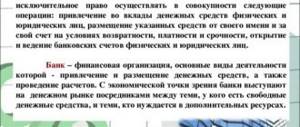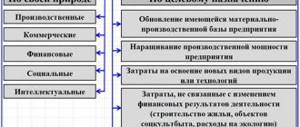Intellectual investments are any investments in intangible assets: training and advanced training of personnel, scientific developments, transfer of know-how, creation of innovative products.
Intellectual property can be collective or individual. Collective property belongs to the cooperative, partners or shareholders. The rights to use individual property belong to a specific person.
Depending on the method of legal protection, intellectual property is divided into:
- Licensed - the rights to use or own property are fixed by licenses.
- Informational - has no legal protection, since it is represented by qualifications, skills, experience, ideas and knowledge. It can only be implemented in the form of services.
- Exclusive - copyrighted or patented.
The essence of these investments
This type of investment represents an investment of funds aimed at developing new, previously non-existent intangible assets. In other words, investments in people's mental activity.
Most often, intellectual investments are realized by investing in the training of employees, improving their skills, as well as organizing seminars and trainings. This is very important, because only a professional can develop a completely new product.
Innovation is currently gaining momentum and is a priority branch of development for both an individual company and the state as a whole. Training and development of an organization's employees is the most important item of intellectual investment. Any enterprise that invests money in this will not go wrong and will reach a new level.
How much is the company worth?
If we take foreign markets, then the value of international companies is on average 43% formed from intangible assets. Of course, there are examples when the share of such assets reaches 80-90%.
For example: Google, Apple, Microsoft and many others. In Russia, even in innovative and high-tech companies, the share of intangible assets does not exceed 5% of the total balance sheet assets. An illustrative example is that a bankrupt airline had assets with a book value of 65.279 billion rubles.
Most of this property is intangible assets. In particular, the company’s brand is still worth almost 51 billion rubles, which is more expensive than all the Aeroflot group brands.
As of December 31, 2021, the Transaero trademark was worth 50.75 billion rubles, another 3.35 billion rubles for the “electronic ticket” trademark (a stylized image of the letter “e”), 4.6 billion rubles for the I-Transaero brand, 2.5 billion rubles - trademark “I-Transaero” (“Imperial”). Transaero estimated the rights to the website transaero.kz and the arrangement of songs for “Sky Crew” at 1.1 billion rubles.
For comparison: the intangible assets of the entire Aeroflot group were estimated at 1.8 billion rubles at the end of 2021, according to the IFRS report.
Intellectual property
A product created as a result of the mental activity of one or more people is expressed in a commodity form. In this regard, intellectual property can be individual or collective. The following types are distinguished:
- Exclusive, which is protected by copyright;
- Informational. This property is determined by the acquired knowledge, skills and abilities, and is realized in the form of a contract through educational services or publication;
- Licensed, expressed in the acquisition by the investor of rights of ownership or use.
There is another type of intellectual property that is not protected by copyright, since it was the product of the activities of several people or teams. This type of property most often turns into regulations or various provisions where all authorship is lost. To protect their rights, authors use special registration forms.
Investments in intellectual property are especially relevant today, since someone's idea or thought can bring in a huge amount of money. You just need to choose the right investment object.
Investment items
The object of intellectual investment can be modern equipment that meets all the latest requirements. With its help, an innovative idea is developed. Also, the subject of investment may be the level of knowledge and qualifications of employees.
But that's not all. The fact is that there are no restrictions in this regard. That is, any innovation or know-how in all areas of activity automatically becomes the object of intellectual investment. One can equally speak of artistic innovations, technological developments and mental products.
The first includes any design decision for a trademark or brand. A technical innovation can be recognized as the creation of previously non-existent equipment or new mechanisms for using old equipment. The new approach to software refers to mental activity. Investments in intellectual property are quite popular, because a new invention can “blow up” the market.
INTELLECTUAL INVESTMENTS - investments in education, training and retraining of personnel, obtaining a license and know-how, joint scientific developments.
[p.318] A special role among the structures that support the development of innovative activities is played by technology park structures that transform input resources (fixed and working capital, investments, intellectual resources) into output innovative services. Technopark structures can vary significantly in the structure and volume of input resources and output services; these characteristics vary over a significant range and determine the form - from the simplest structures such as scientific hotels, which can be located in one small building and provide 2-3 types of services, to technopolises or regions of science, occupying a significant space and representing complex regional economic complexes with an innovation orientation. According to the increasing degree of complexity, technology park structures can be arranged as follows: incubators, technology parks, technopolises, regions of science and technology. [p.62]
INTELLECTUAL INVESTMENTS - see INTELLECTUAL INVESTMENTS [p.259]
INTELLECTUAL INVESTMENTS - financial investments in scientific development, research, testing, training of sufficiently qualified personnel, transfer of licenses and know-how, etc. [p.244]
Competition in the market of intellectual property (patents) by establishing a patent monopoly, which allows you to confidently control the relevant sector of the product market. Patent blocking requires significant investments in the development of pioneering inventions and the formation of patent blocks that ensure sustainable monopolization of the product market. [p.27]
Improving your knowledge management process should be viewed as increasing your company's intellectual capital, an investment in increasing your corporate IQ, which will ultimately enable your company to make the best collective decisions and implement the best collective actions based on them. Intellectual capital is not just a concept from management theory. Behind this term there is an assessment of the intellectual property of the organization and the knowledge that its employees have. Financial analysts are attaching increasing importance to the quality of management of intellectual property and intellectual resources, including it in the list of evaluated parameters along with the material assets of the enterprise and its position in the market. They argue that companies that properly manage their intellectual capital will emerge as market leaders in the coming years, regardless of their position today, and value them accordingly. [p.266]
In the most common market sense, investment refers to the investment of funds. Investments are all types of property and intellectual assets invested in business objects or other types of activities, as a result of which profit is generated. [p.89]
However, it is necessary to concentrate the attention and efforts of society on the area of creating IIN facilities and, most importantly, on the area of effective use of these facilities. In other words, investments in the real economy must clearly and prioritize an appropriate share of investments in information and intellectual production (IIP). In this way, intellectual development and integration of the intellectual space of Russian society with its economic space will be automatically ensured. [p.261]
In BITs with the participation of Russia, the definitions of investments are mainly used: any type of property assets (Clause 1, Article 1 of the BIT with Japan), all types of property and intellectual assets (Article 1 of the BIT with Kazakhstan). [p.36]
Know-how, like other objects of intellectual property, being direct investments, are intangible assets, each of which has its own value. [p.49]
The circulation of investments in the sphere of reproduction of physical capital (movable and immovable property) can be described as follows. Investments are made in investment goods to create material prerequisites for commercial activity. Investment capital in various forms is advanced into specific types of goods, collectively representing physical capital. Cash investments can be made into any element of physical capital. Investments in commodity form made in commercial activities are directly transformed into tangible elements of capital. Investments in the form of property rights are realized in the process of reproduction as the use of experience, know-how and other intellectual values. [p.347]
Investments are made in the form of long-term investments of resources in cash, targeted bank deposits, shares, shares and other securities, technologies, machines, equipment, licenses, including trademarks, in any other property or property rights, intellectual values for the purpose of making a profit and achieving a positive social effect. [p.198]
Chapter 30. FOREIGN INVESTMENTS Foreign investments are all types of property and intellectual assets invested by foreign investors in business objects in order to make a profit. The source of foreign investment is the financial and credit resources of non-residents. Foreign investors are recognized [p.216]
The objects of foreign investment on the territory of the Russian Federation are newly created and modernized fixed assets and working capital, securities, targeted cash deposits, scientific and technical products, rights to intellectual values, property rights. [p.217]
Foreign investments include all types of property and intellectual assets invested by foreign investors in business activities in order to make a profit. They are carried out on various terms, including concessions, under production sharing agreements, and in free economic zones. [p.225]
Current foreign exchange transactions include (1) transfers to and from the Russian Federation of foreign currency for making settlements without deferment of payment for the export and import of goods (work, services, results of intellectual activity), as well as for making settlements related to export lending import transactions for a period of no more than 90 days (2) receipt and provision of financial loans for a period of no more than 180 days (3) transfers to and from the Russian Federation of interest, dividends and other income on deposits, investments, loans and other transactions related with capital movements (4) non-trade transfers to and from the Russian Federation, including transfers of wages, pensions, alimony, inheritance, as well as other similar transactions. [p.601]
Foreign exchange transactions related to the movement of capital include (1) direct and portfolio investments (2) transfers in payment of ownership of buildings, structures and other property, including land and its subsoil, classified as real estate under the legislation of the country of its location, and as well as other rights to real estate (3) provision and receipt of deferred payment for a period of more than 90 days for the export and import of goods (work, services, results of intellectual activity) (4) provision and receipt of financial loans for a period of more than 180 days (5) all other foreign exchange transactions that are not current foreign exchange transactions. [p.601]
Intangible assets include patents, licenses, trademarks and trademarks, rights to use natural and other resources, computer software products, new technologies and technical solutions that bring benefits in the process of economic activity. Investments in intangible assets pay off over a certain period due to the additional profit received by the enterprise as a result of their use, and due to depreciation charges. With the development of market relations, the size and share of intangible assets in the total capital of the enterprise increase. Economic interest in increasing the profitability of an enterprise through the use of the enterprise’s exclusive right to the results of intellectual activity is also increasing. Hence, analysis of the efficiency of using intangible assets is important. The technique is most fully described by A.D. Sheremet [59]. [p.347]
By their nature, investments are divided into production, commercial, financial, social, intellectual, etc. [p.579]
In our opinion, some formulations in the list of operating income are not successful enough, according to which neither intellectual property rights, nor investments in the capital of other organizations, nor funds lent are assets. Assets are only that which can be provided for a fee for temporary use [p.392]
Investments are considered all types of property and intellectual values that are invested in objects of entrepreneurial activity that generate profit (income) or achieve a social effect. Investments in the assets of the enterprise are reflected on the left side of the balance sheet (asset), and the sources of their financing are reflected on the right side (liability). [p.208]
According to the economic content and current legislation in Russia, investments are defined as cash, targeted bank deposits, shares, shares and other securities, technologies, machinery, equipment, licenses, including trademarks, loans, any other property or property rights, intellectual values invested in objects of entrepreneurial and other types of activity in order to generate profit (income) and achieve a positive social effect. [p.480]
Before moving on to consider this issue, it is necessary to emphasize that with the transition to the market, the understanding of such categories as investment and objects of investment activity has significantly expanded. In accordance with the Law on Investment Activities of the Russian Federation No. 89-FZ dated June 19, 1995, investments are cash, targeted bank deposits, shares, shares and other securities, technologies, machines, equipment, licenses, including for commodity signs, loans, or other property or property rights, intellectual values invested in business objects and other types of activities in order to generate profit (income) and achieve a positive social effect. [p.425]
This is explained by the fact that investments reflect all types of material and intellectual values that are invested in business objects, and that, due to the unpredictability of the market environment, they carry with them the risk of not only receiving income from their investment, but also of their complete loss. Hence the need to manage this process is clear. Due to the fact that investment activity affects many aspects of the functioning of an enterprise - production and sales, economic and financial - its management is complex. So, for example, the choice of a particular project is associated with determining the possibility of producing those goods that are in demand on the market, which is the prerogative of the marketing and production management service, and determining the results of its implementation and ensuring the financial stability and solvency of the enterprise is the task of financial management. Therefore, it is believed that the organizational structure of investment management should be matrix with direct subordination to the chief engineer. The unification of all management services should be the development of an enterprise's investment policy. [p.690]
All over the world, the development of e-business has potential risks, including fraud, tax evasion, non-compliance with confidentiality, and violation of intellectual property rights. In Russia, due to extremely low business ethics, these risks are much greater. Authorities must maintain and implement a transparent legal and operational environment, which is especially important for Russia, which has developed for decades in conditions of almost complete closure of information. Opening up the communications industry is critical to attracting investment and increasing competition. Currently, this area is strictly monopolized, and communications market monopolists take advantage of their exceptional position to limit development and investment. Thus, in the absence of effective competition, telephone companies set artificially high prices for leased lines by network providers and for local exchange services, limiting their use and preventing the provision of services. [p.577]
INVESTOR - a legal or natural person who makes a decision and invests his own, borrowed and other attracted property and intellectual assets in an investment project. I. can act as a depositor or creditor. He independently determines the volumes, directions and effectiveness of investments. By order of I., the rights to own, use, dispose of investments and their results can be transferred to individuals and legal entities in the manner prescribed by law. I. has the right to own, use and dispose of objects and results of investments, including reinvestments. I. is different from a speculator. Unlike I., a speculator takes a calculated risk, and a gambler takes any risk. [p.93]
According to the status of a member of the national level, Russia, as a member of the ICC, can participate in the work of international technical commissions (on taxes, international investments, marketing, banking, trade, management, environment, intellectual property and a number of other problems), receive on preferential terms most of the publications published by the ICC, take part in congresses, conferences and other events organized under its auspices. The headquarters of the ICC is located in Paris. INTERNATIONAL BIDDING is a competitive form of placing orders for the purchase of equipment on the world market or attracting contractors for the construction of complete facilities, performance of other work, including the provision of engineering and consulting services. The conditions of the competition are announced in advance. [p.131]
The principles of forming the share capital of the INF require maintaining the unity of the research and production complex and its resource potential of attracting strategic partners in innovation activities to participate in the share capital, necessary for the development of investments and concentrating large blocks of shares with the creators of innovations who form the intellectual core of the company. [p.156]
By the 80s. XX century As a result of the implementation of the extroverted liberalization policy of freedom of trade competition within the framework of the General Agreement on Tariffs and Trade (GATT), the United States and other industrialized countries managed to practically ensure maximum freedom of trade expansion for industrial goods, and in essence almost on a global scale, because by the 80s XX century A very small minority of the world's trading states remained outside the GATT system. On the agenda was the issue of further spatial and substantive expansion of freedom of trade on the world market, extending this freedom not only to the market of goods, but also services, investments, intellectual property, etc. These problems were the subject of agreement within the framework of the Uruguay Round of GATT in 1986-1994. (see 285,286). [p.19]
Investments = v (Government investments Cash Foreign investments Intellectual values Credit Machinery Equipment Technologies Target bank deposit Securities), s (Protection of investments Investment activity Entrepreneurial activity Investment insurance) [p.173]
When the company's managers appeared before the company's board of directors, they asked for a billion dollars, just in case, for technology that would support the company's leadership position in the financial sector. A billion dollars is a serious investment in the future. The main focus of the board's discussions, however, was not costs or return on investment. It was about survival and future prosperity. About how to continue to resist traditional competitors and cope with new types of competitors. The Council agreed that the best way to compete is to provide knowledge workers with quality knowledge tools. [p.98]
The country's raw material specialization and its integration into world economic relations along the export of raw materials - import of mechanical and consumer goods leads to unequal foreign economic exchange and a chronic lag in the level of economic development. This happens due to the peculiarities of pricing for engineering and raw materials products. The most important component in the first case is intellectual rent, which is formed as a result of a temporary monopoly on the use of scientific and technical innovations and serves as a source of financing for subsequent scientific and technical developments and economic growth, in the second - natural rent, which goes mainly to pay machine builders for products, consumption and only partially can be used to finance investments. With the country's resource specialization, natural resource rent is exported in exchange for inflation imports, i.e., economic growth is financed abroad through unequal foreign economic exchange. The scale of such resource flows can be quite significant. Thus, in the price of new electronic equipment and its software, the share of intellectual rent exceeds 50%. [p.141]
In other words, innovative production is a dialectical unity of material (tangible) and anthropocentric (intangible) production systems. The result of the first is a material product, the result of the second is intellectual capital - knowledge that can be used in the organization to gain various kinds of advantages over competitors. In Western theory, this provision is interpreted as follows: as soon as investments in research and development exceed investments in fixed assets, the company transforms [p.52]
Here it must be emphasized that definitional clarity is of great importance not only from a theoretical-analytical, but also from a practical point of view, allowing one to reliably identify the object and subject of influence and build optimal relationships between them. As T. Stewart says, what is required is not just a definition of intellectual capital, but also a description of it, with the help of which managers can plan investments in intellectual funds and manage them [8, p. 112]. Intellectual capital management is an important area of management activity in modern society. E. Brooking identifies such types of activities in intellectual capital management as identification of intellectual capital, development of policy regarding the development of intellectual capital, audit of intellectual capital, documentation of intellectual capital, protection of intellectual capital, distribution of intellectual capital, increase and renewal of intellectual capital [7]. [p.59]
The issue of indirect seizure requires special consideration, which does not consist in physical possession of the investment object, but in the invasion of rights in the field of intellectual property, rights arising from shares, etc. Western specialist Higgins was one of the first specialists to point out the almost complete absence of any analysis of the conceptual aspects of property in the field of investment relations. [p.82]
Considering that the company's transition from traditional management methods to electronic business requires significant investments, it is advisable to highlight their main directions. The central direction in this set (investments in information resources, information technologies, intellectual investments, etc.) are investments in the company’s technological capabilities, an Internet access channel, licensed software, creation of a local network (Intranet), registration and support of a domain name (gi, cellular), providing access to remote users and updating information resources, providing a server protection system, creating search engines, creating a billing system, creating an Internet trading system, creating a P-telephony and P-television system, providing provider services, technological support for the server, investments in Zhey-design and Internet banking, investments in regional and international information technology networks, implementation of infrastructure projects. [p.564]
Why invest in intelligence?
These investments have received a lot of attention lately. This is due to the fact that many authoritative experts have expressed the opinion that this kind of investment can, in a short time, completely change the economic structure of both the enterprise and the state.
This statement is not unfounded, because Russia, according to Prime Minister D. A. Medvedev, is taking the path of innovation. At the moment, our country has a resource-based economy, which significantly hampers its development. Only investments in intellectual capital can take the country's economy to a new level.
These investments have a number of strengths, one of which is the minimal cost involved. Before creating a new product, it is necessary to complete a number of tasks: find qualified workers, provide them with modern equipment, and also create previously non-existent technology.
Why do you need to start managing intangible assets and do it soon?
- Pledge of rights to IP objects when lending will become a reality in the near future; there are all the prerequisites for this, the main one of which is reducing the significant gap in the development of high technologies from foreign markets.
- Creation of a unified blockchain platform for intellectual property management in Russia. The initiators of the project are copyright societies, the Skolkovo Foundation and a number of universities.
- One of the main tasks of RVC for the near future: popularization and stimulation of the expansion of the practice of providing rights to intellectual property as collateral in order to obtain bank financing.
What just recently seemed like a fantasy for Russian business will soon begin to actively work. Those who prepare in advance will be able to win the competition against their less efficient colleagues.
Implementation of intellectual investments
The type of ownership determines the further “fate” of mental goods and services. Most often they turn into investment objects, but they can also be sold in consumer markets. The investor acquires mental products with the aim of using them in business activities, and, accordingly, future profits. Intellectual investments are investments in this type of property.
They are carried out in the form:
- acquisition of patents, copyrights and licenses;
- purchases of information services;
- purchasing intellectual products in the form of material goods, information contained in any media: from printed materials to a hard drive;
- investments in the workforce (education, advanced training, etc.).
New centers are now being established to promote mental investment. One of such institutions is the ITA “Intellectual Investment Laboratory”. Reviews about the company's activities are only positive. Such centers can help people and take intellectual investment to a new level.
Sources of financing
All investments are financed from somewhere, and any smart investor should understand this. No one will invest money in a project that does not have a source of funds. Since the state considers this area quite important, it acts as the first source of funding. Intellectual investments are supported from budgets of various levels.
The second source is a group of large companies that are no less interested in creating new ideas and products than the state. Innovation will help them increase their income even more, which is why corporations are providing financing.
The third source seems to be the most insignificant. Various non-profit organizations that exist with government support are engaged in financing in search of innovative solutions.











